Despite Games Workshop's trend of childish tone and approach to their gamers, the truth is that there is also a big segment of older hardcore gamers and miniature painters that love to read their books, play their games and paint their miniatures. In this post I'll make a short recapitulation of GW's evolution, focusing mostly on their miniatures and their magazine, White Dwarf.
This is not a deep study, just a grasp. The hyperlinks in this post lead to much more detailed resources, so if you are interested check them ;)
The two best ways of learning about the past are first reading documentation about it, and second analyzing their legacy. I have tons of White Dwarf magazines and I've read most of them, plus swimmed through the net for info, dates and facts.
Games Workshop started in the seventies building simple games and importing USA RPGs into UK, working at the beggining via mail order only.
Success came in, and apart from funding Citadel Miniatures they also reprinted old discontinued RPGs (which they would absorb years later). They shifted from having the main HQ in USA to England.
White Dwarf started as a general-purpose RPGs and boardgames magazine, with heavy focus on Dungeons & Dragons. Most content of the magazine in the first numbers would be non-Games Workshop specific, and it was mostly black & white.
After the success of Games Workshop and their strategy games Warhammer and Warhammer 40.000 (Rogue Trader in its first version), the magazine shifted to give more pages to their products, becoming clearly focused on them around issue #100.
Apart from building a chain line of official shops, the main income was from mail orders, always present at the last pages of the magazine and featuring the latest miniatures for their games.
Before 1992, White Dwarf had lots of games, both spin-offs/alternate universes containing races from the main Warhammer/40K universe and new settings, like a Max-Max style racing and shooting car game or Blood Bowl.
At the end of 1991 the company decided to focus on their most known and profitable franchises, Warhammer and Warhammer 40.000, slowly removing content from the magazine of the other games and ending up discontinuing them.
After the Lord of the Ring movies, Games Workshop bought the rights to create official content, and since then it has become another main line of production (having a moderate success, but that's another story).
Older editions of the magazine contained lots of new content, new rules and small expansions, but actually and probably as a market strategy they tend to release official expansions and army books (codex in the case of Warhammer 40.000), offering some freebies but overall reducing the magazine's "new" content to lore and some excerpts of them.
Focusing on the miniatures and drawings, as I'm a Warhammer 40.000 player I´ve prepared some comparisons to visually see the difference and evolution of them. From an initial sometimes chidish/funny look sometimes more serious approach, now all races (with specific exceptions like the goblins/gretchins) of all games have a harder, serious tone.
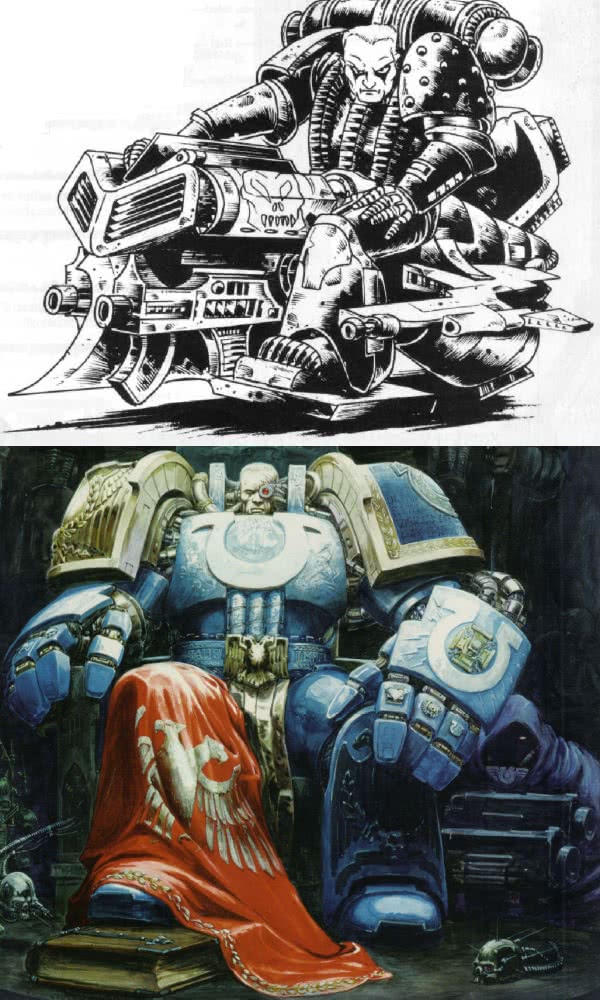
The drawings are the best example. From mostly B&W images of normal-sized humans in armor to the actual badasses in huge power armours, all Warhammer 40k images have changed a lot. Current drawings are insanely detailed and depict a trully grim and dark sci-fi future.
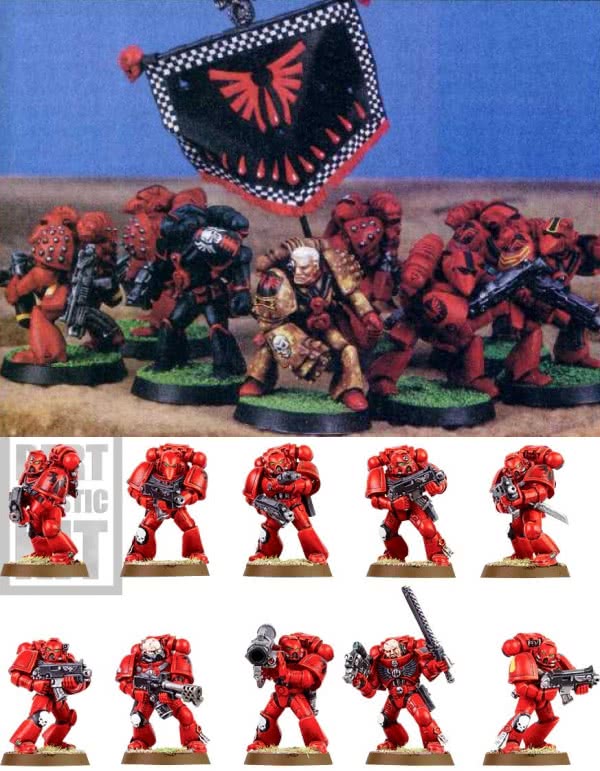
Space Marines visual style changed from the old MK.VI (Rogue Trader) armour to the MK.VII armour, with bigger miniatures, bigger weapons, and being the main symbol of the Warhammer 40.000 universe, it's one of the armies with the biggest miniature range.
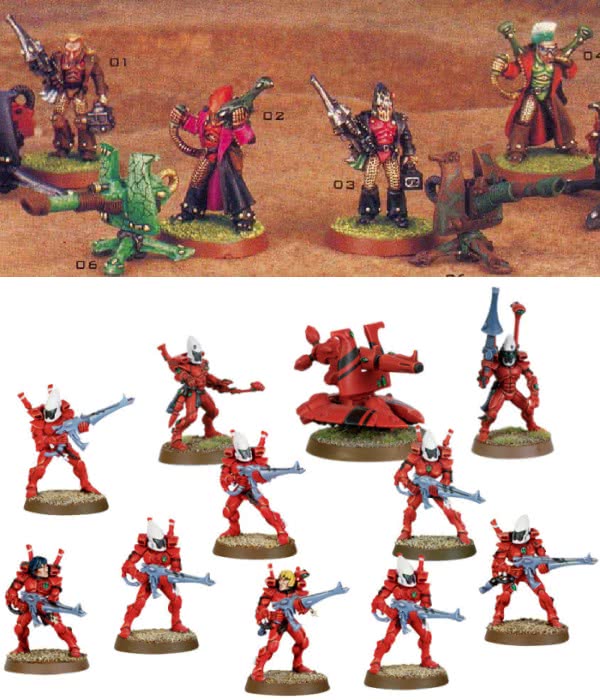
The Eldar started as rogue pirates, with multi-coloured clothes and semichaotic organization, but the basics (their anti-grav cannons, shuriken rifles and distinctive helmets) were there. This race has become more militarized since then, becoming neutral guardians instead of pirates, and even spinning off another race, the Dark Eldar, to have an evil counterpart (recently redone in 2010, by the way).
Current colors are more uniform, differentiating per craftworlds (armies), but almost all non-basic troops have special one-option only color schemas. The original multi-coloring and flashy looks are only present noew in the Harlequins.
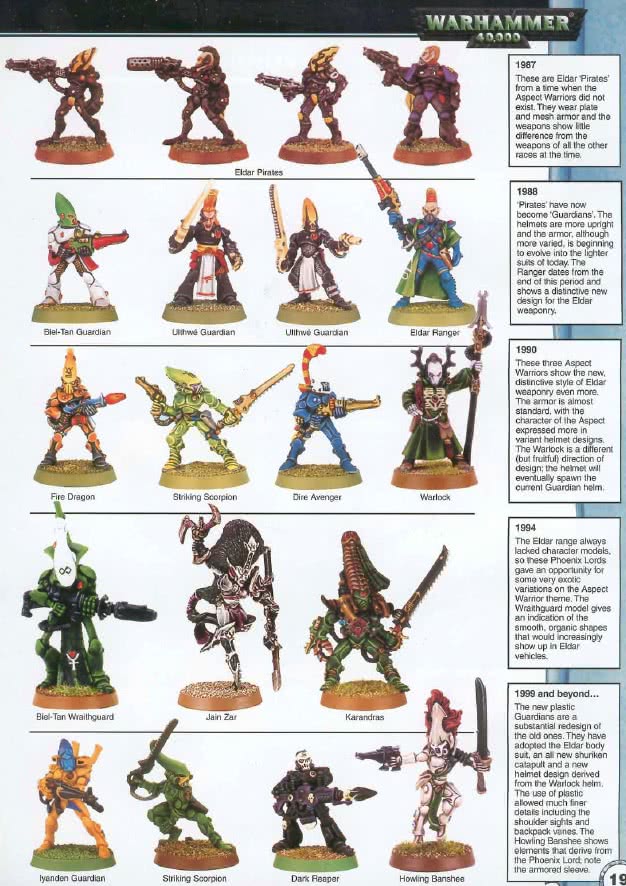
If you click on this image you will see a nice evolution of the Eldar miniatures.
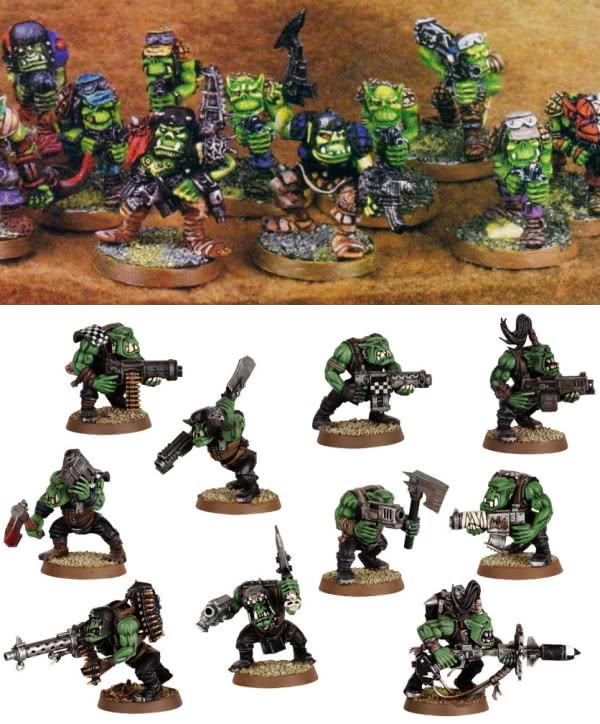
Orks are no longer funny creatures wearing looted human clothes, but scary green monsters. Ork clans were defined, each with their color schema (some being still multi-colored, others more uniform). They now have their own vehicles, although is very common to do modifications on tanks and Space Merine Rhinos to create "ork looted vehicles". They are now one of my favourites and have most Space Marine unit counterpars, but with their "messy" touches.
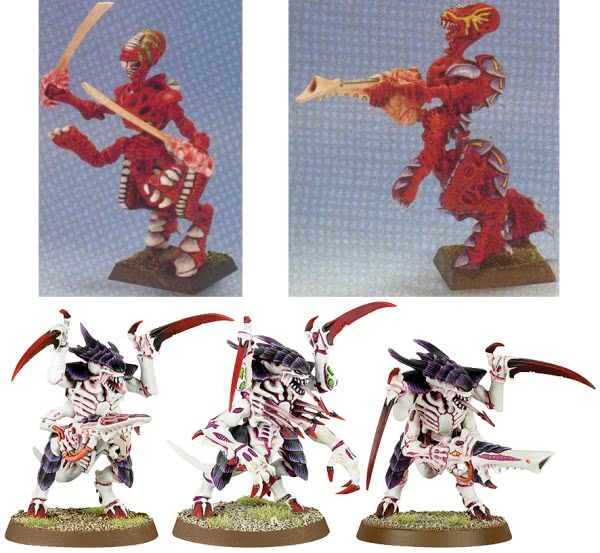
The Tyranids appeared after the Genestealers of Space Hulk, and the lore of the later was modified to convert them into the main melee troops of tyranid hives. The original design was so different from the Genestealers that they suffered a redesign, all units being now more alien-alike, with scales, long heads and similarities. Genestealer hybrids have sadly dissapeared from the tyranid army (and their miniatures discontinued), but as I said above at least now all the miniatures are consistant in the base appearance.
I could have added tons of more images, but a few examples are more than enough to depict the evolution. In the past looked like the sculptors would create all kind of miniatures without any restriction, while now they adhere to some race requisites. Also now all the miniatures share the general serious, violent and grim appearance.
Games Workshop also moved away from lead metal ones to lead-free alloys for those miniatures whose details cannot be properly done in plastic, but the trend is to generate plastic kits as the prefered option.
Also all current plastic kits contain some degree of customization out of the box, which combined with the advances in plastic molding give us the collectors really customizable and moddable miniatures.
The lore and background of both Warhammer Fantasy and Warhammer 40.000 has grow to insane amounts. There are lots of books (with new ones published each year) at the official GW's editorial, The Black Library. Army books contain lots of stories and background, and the number of videogames based on both settings grows almost every year also. White Dwarf also publishes in some issues lots of content, and just the images are awesome.
Money always end up changing the path of companies, but Games Workshop at least maintains a collector's section where you can still find some old miniatures from discontinued games (but expect to pay accordingly!).
I hope this small article pleases your old times desire for information. We'll see ten years from now how much more has everything changed ;)